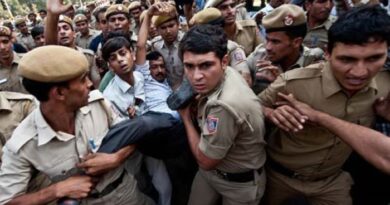New Version of RAMYANA is Creating Ripples
Like, Share, Follow, Comment, & Support… be the voice of Free Press! Thanks
By Syed Ali Mujtaba. Copy Edited By Adam Rizvi. TIO: A fresh attempt is being made to rewrite the Ramayana, the famous Indian epic. This is done by Amish Tirpathi where he likes to continue the legacy of poet Valmiki who wrote the first version of Ramayana in 500 BC.
According to A. K. Ramanujan, there are “Three Hundred Versions of Rāmāyaṇas that exist today where there is no unanimity with the authors in depicting the characters of the epic.

A few versions of Ramayana are; Kamba Ramayanam, a Tamil epic written by the Tamil poet Kambar during the 12th century. Poet Krittibas Ojha wrote Kttivasi Ramayana in Bengali in the 15th century. The Ramcharitmanas was written by Tulsidas in 1631. The ‘Lakshman Rekha’ tale is purely a piece of the imagination of Tulsidas as poet Valmiki does not mention it in his version of Ramayana.
Also, Read Happy Bandi Chhor Divas, The Story Behind. Happy Diwali
Now after a gap of three hundred years, another version of Ramayana is attempted by Amish Tripathi through his Ram Chandra Series where he tries to retell the most famous epic of India. Each book in the series focuses on one important character of the Ramayana that necessarily does not confirm with the characters of the previous Ramayana.
Amish Tripathi, in his second book of the five books, Ram Chandra Series tries to depict the character of Sita as a warrior of Mithila’ and the new narrative of Ramayana goes like this…
During a trip to Janak, the king of Mithila and his wife Sunaina find a child on the road, being protected by a vulture. They adopt the child and name her Sita, for she was found in a furrow. As an adolescent, Sita is sent to the ashram of Rishi Shvetaketu for her studies. There she learns about martial arts and gains knowledge on different subjects. She also makes friends with a girl Radhika, and her cousin Hanuman, who was a Vayuputra—the tribe left by the previous Mahadev, Lord Rudra.
Also, Read: Navaratri, Other Systems Of Dieting; But Persian Maxim Trumps Them
When Sita is 14 years old, Maharishi Vishvamitra—head of the Malayaputra tribe who serves the next Vishnu—visits Shvetaketu’s ashram. Impressed by Sita’s skills and knowledge, he elects her as the seventh Vishnu but asks her to keep it a secret. Sita also wins the trust of Jatayu, a Naga member of the Malayaputras.

After Sita returns to Mithila, she is bereaved upon her mother Sunaina’s death. She also has to take care of her younger sister Urmila. With Janak being engrossed in spiritual work, Sita is made the Prime Minister of Mithila. She is able and makes many reforms in the kingdom with the help of her childhood friend Samichi, who served as the chief of the police force.
After Mithila’s financial condition stabilized, Sita visited the Malayaputra capital city of Agastyakootam to continue training for becoming the next Vishnu. However, she starts suspecting Vishwamitra’s reasoning for choosing her over Rama, the prince of Ayodhya, and the son of King Dashrath the supreme ruler of India.
Through Radhika, Sita comes to know that Ram was also being considered for becoming the next Vishnu by his mentor Rishi Vashistha—an old friend of Vishwamitra.
Sita plans a marriage alliance with Ram through a Swayamvar but is enraged to learn that the Lankan king Raavana and his brother Kumbhakaran have also come there.
Also, Read India’s rising surge of ‘Hindu’ nationalism!
She manipulates the situation with Vishwamitra so that Ram’s name is announced as the first suitor. Ram wins the Swayamvar and marries Sita, while his brother Lakshman marries Urmila.
The next day, Raavan besieges Mithila with 10,000 soldiers, and Ram is forced to use the biological weapon Asurastra by Viswamitra, even though its usage is forbidden by Lord Rudra. The Lankan army is defeated and Raavan escapes on his helicopter, Pushpak Viman.
Ram returns to Ayodhya and decides to take a 14-year exile as punishment for breaking Lord Rudra’s rule. Sita holds a grudge against Viswamitra for forcing Ram to use the weapon and never speaks to him. Together with Lakshman she joins Ram on the exile, but enlists help from Jatayu and his men, to protect Ram and supply the trio with the anti-aging drink, Samaras. Numerous incidents take place during their exile and thirteen years pass by.
Also, Read India: Intimations of an Ending. The rise of Modi and the Hindu far right.
One day, with Ram and Lakshman out hunting, the camp is attacked by Raavan and his soldiers. Sita rushes to help a wounded Jatayu but loses the fight against so many soldiers. She is abducted and carried unconscious into the Pushpak Viman. Once she regains consciousness she attempts to kill Raavan in the vehicle but is stopped by a woman drawing a blade to her throat. With Raavan being alerted, Sita turns back and is startled to see that it is Samichi, Sita’s childhood friend!…. The story continues…
Read more by Syed Ali Mujtaba: Snapshot of Muslims in Seemanchal Region
Curated & Compiled by Humra Kidwai




